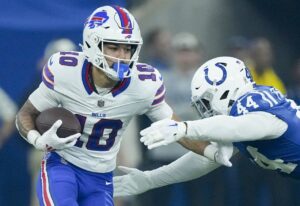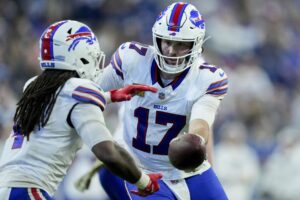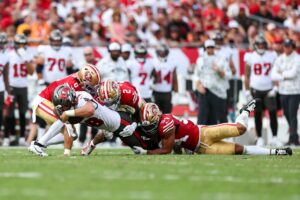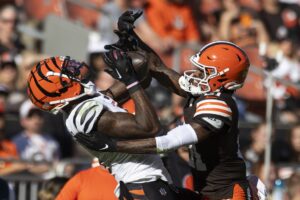The New Orleans Saints made enormous strides on defense last season, improving from the NFL’s second-worst scoring defense in 2016 to 10th-best in 2017. One of the strongest position groups was at safety, where rookie Marcus Williams quickly emerged as a reliable deep safety and playmaker. Meanwhile, his counterpart Vonn Bell showed significant growth in his second season.
Due to the high success at the position, few expected much movement at safety during the off-season. New Orleans surprised everyone by signing eight-year veteran Kurt Coleman to a three-year, $16.35 million contract prior to free agency. They also let 2013 first-round pick Kenny Vaccaro hit free agency in a widely anticipated move and chose not to re-sign backup Rafael Bush.
There were more pressing concerns on the roster after the season, but it’s clear by the Coleman signing that New Orleans still sought significant improvement at safety. With Coleman on board, this position should be even better in 2018 and they stand as one of the strongest safety groups league-wide. The biggest question for this unit concerns how playing time will be distributed amongst Williams, Bell, and Coleman.
New Orleans Saints 2018 Safety Breakdown
Marcus Williams
For much of the 2017 season, the excellent play of Williams flew under the radar as the Saints pass defense executed their stunning turnaround. Fellow rookie defensive back Marshon Lattimore seemed to get much of the credit. This was likely due to his higher draft selection and Williams quieter role downfield. Unfortunately, Williams didn’t gain much name recognition until he missed a crucial tackle on Stefon Diggs in the closing seconds of the Saints postseason loss to the Minnesota Vikings.
While that missed tackle will forever be replayed and discussed, the momentum-shifting interception Williams made late in the third quarter should not be forgotten, nor should his valuable contributions made throughout the season. Williams accumulated four interceptions and broke up seven passes in 2017, but his most significant impact doesn’t show up on his individual stat line.
Before Williams was drafted, opposing quarterbacks routinely gashed the Saints defense, and it didn’t seem to matter who the passer was. In 2015, New Orleans allowed 7.9 adjusted yards per pass attempt and 7.2 in 2016. Last season, that number dropped dramatically to 6.0 adjusted yards per attempt. Without Williams downfield, it’s unlikely New Orleans would have so successfully reduced opponents pass production.
For his part, Williams has used his lowest moment as a source of motivation, hitting the gym harder than ever before and keeping a positive mindset. He also has the full support of everyone around him and figures to lock down the starting free safety job again. Coleman may threaten Williams for playing time, but there are better uses for his wide range of skills and Williams is thriving in his current role.
Vonn Bell
Despite being overshadowed by the Saints excellent 2017 draft class, second-year players like Bell were just as crucial to the Saints defensive turnaround. Bell did it all last season. He spent a lot of time playing near the line of scrimmage while also starting at strong safety in several games. Bell recorded a team-leading 57 tackles and finished second on the team with 4.5 sacks.
Bell is more likely than Williams to see reduced playing time at the hands of Coleman. New Orleans frequently utilizes three-safety sets, so all three should get plenty of time. However, it remains unclear who the starting strong safety will be. Despite Vaccaro’s struggles throughout the season, he remained the starter when healthy in 2017. When Bell started though, he played just as well if not better than Vaccaro.
The Saints third safety tends to play close to the line of scrimmage; playing man coverage on tight ends and running backs while also blitzing frequently. Bell has played this role well in the past, so it should come as no surprise if he ends up as the third safety. While Bell has been decent in downfield coverage, Coleman’s years of experience at free safety make him a better candidate for playing the more traditional strong safety position away from the line of scrimmage.
With both players possessing versatile skill sets, New Orleans could make Coleman and Bell’s roles virtually interchangeable with the duo splitting time between the strong and third safety spots. This would provide a source of confusion for opposing offenses and offer some peace of mind if either player gets injured. Regardless of where he ends up, Bell is a surging player with a bright future.
Kurt Coleman
The Saints were already quite familiar with Coleman before signing him. He played in nine games against New Orleans dating back to 2012 and picked off Drew Brees twice in that span. Coleman’s best season was in 2015 when he recorded seven interceptions, nine pass breakups, and a sack on the way to a Super Bowl appearance with the Carolina Panthers.
The Coleman signing does come with some risk. Knee and ankle injuries hindered his play last season and ultimately caused him to miss four games. Coleman received a 46.9 grade from Pro Football Focus which ranked 76th among safeties in 2017. He should be fully recovered by now, but his dropoff in play was concerning enough for Carolina to cut him with a year remaining on his contract.
Coleman’s $5.45 million per year contract shows the Saints expect him to return to his 2015 form. He brings great versatility to the secondary with experience at both safety positions and proven success covering slot receivers. Bell will give Coleman a run for his money at strong safety, but this signing indicates New Orleans isn’t ready to make Bell a full-time player.
The Saints could have re-signed Bush or found a less expensive option than Coleman if they just wanted a part-time safety. Coleman offers 74 games worth of starting experience, bringing valuable experience to a young, budding defensive backfield. As previously stated, Bell will still have a large role if New Orleans continues using three-safety sets on a regular basis.
The Rest
While Williams, Bell, and Coleman are obvious locks for the roster, it’s unclear who will be their immediate backup. One strong candidate is rookie Natrell Jamerson, who earned honorable mention All-Big Ten honors last season after posting 51 tackles, 1.5 sacks, two interceptions, and 10 pass breakups. That was Jamerson’s first full season at safety, making his success even more impressive. However, his inexperience could make for a difficult NFL transition.
The Saints also drafted defensive back Kamrin Moore a few picks later in the sixth round. He hasn’t played safety since high school, but he should still get looks at the position with so many other players already competing for a cornerback spot. Five-year veteran Chris Banjo is another possible candidate. He has minimal experience playing safety at the NFL level, but Banjo did record his first interception last season and his special teams play has kept him on a roster throughout his career.
Rounding out the position are longshots J.T. Gray and Sharrod Neasman. Gray is an undrafted free agent out of Mississippi State with experience at safety and linebacker. Neasman previously played a special teams role with the Atlanta Falcons and has five tackles in two NFL seasons. Both are likely practice squad candidates with all the talent ahead of them.
Position Outlook
The Saints don’t employ a truly elite player at safety, yet the trio of Williams, Bell, and Coleman is a force to be reckoned with. In Williams, the Saints have their best free safety since Darren Sharper last played in 2010, while Bell and Coleman are versatile options that can handle multiple responsibilities. There’s no obvious fourth option at this point, but New Orleans has enough talent and competition there to form a decent cast of backups.
A few years ago, the Saints struggled just to find two adequate starters at safety. Now they have three starting caliber safeties and three athletic rookies behind them. It’ll be shocking if this position doesn’t perform even better in 2018.






